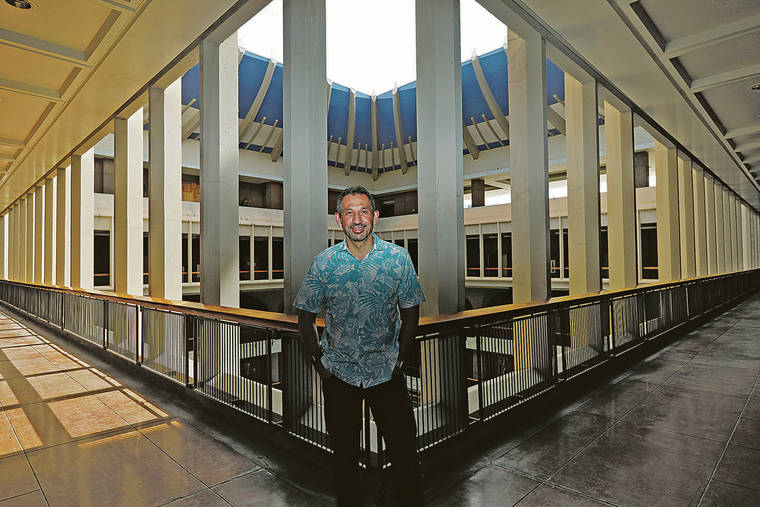Alaska Airlines’ next CEO optimistic on recovery and ‘pent-up demand for Hawaii’

STAR-ADVERTISER / OCT. 16
Ben Minicucci
Ben Minicucci, who was tapped last week to become Alaska Airlines’ next CEO, says the carrier expects to put more focus on Hawaii in 2021.
Alaska has been dramatically affected by COVID-19. It’s parent company Alaska Air Group Inc. reported a third-quarter net loss of $431 million as compared with net income of $322 million in the third quarter of 2019.
But Alaska reported it has improved in each of the last six months in terms of flights offered and passengers carried, and its net debt hasn’t changed. The carrier is better positioned than some to come out of the slump because prior to COVID-19 it was less reliant than other carriers on business travel, which made up only about 30% of Alaska’s business.
As the pandemic wages on, Minicucci told the Honolulu Star-Advertiser that leisure travel will become even more important to Alaska and as long as there is demand. “Hawaii is in that sweet spot,” he said.
Prior to COVID-19 the carrier flew over 45 million guests a year to more than 115 destinations on 1,300 daily flights across the U.S. and to Mexico, Canada and Costa Rica.
Hawaii always has been a big part of that focus, Minicucci said.
Don't miss out on what's happening!
Stay in touch with breaking news, as it happens, conveniently in your email inbox. It's FREE!
“Hawaii is a huge part of our network. In terms of available seat miles or revenue, it’s 15%, which is a significant portion of our network and revenues,” he said. “First, it’s just a big part of who Alaska is today, and secondly, it’s a huge part of our growth over the last 13 years. Our success has been part of our Hawaii growth. It’s always in our radar.”
Minicucci, who traveled to Hawaii for the Oct. 15 reopening of trans-Pacific travel, said he was thrilled by the state’s pre-arrival testing launch, which coincided with Alaska’s 13th anniversary in Hawaii.
“Just look at what happened (Oct. 15). I think there’s pent-up demand for Hawaii,” he said.
Some 8,224 passengers flew into Hawaii on Oct. 15. On Saturday, incoming passengers peaked at 9,155. While those numbers are far below last year’s counts, they represent a start.
Minicucci said it bodes well for Hawaii that beach destinations are the top choice of U.S. travelers who would book travel in the next three months, according to a Google COVID-19 and Traveler Intent survey conducted in October.
He also thinks Hawaii could benefit from the trend toward remote work and schools.
Another development that’s good for long-haul destinations like Hawaii is that the latest research from the Harvard T.H. Chan School of Public Health shows that there is low risk of COVID-19 transmission on airplanes.
“There is a full exchange of cabin air with outside and HEPA-filtered air every 2-3 minutes and 100% fresh air every 6 minutes,” the airline said.
At its pre-COVID peak, Alaska was operating 36 flights into Hawaii. Since Hawaii’s pre-arrival testing launch, the carrier has restored flights, and expects to be up to 22 daily flights across four islands by the end of the year.
Alaska began flying to Hawaii on Oct. 12, 2007. The carrier first flew between its Seattle hub and Honolulu and then added additional routes from the Pacific Northwest. Following Aloha Airlines’ bankruptcy, Alaska saw a need to fill a void and launched nonstop service to secondary West Coast cities.
Before the pandemic, Alaska had offered the most West Coast flights of any carrier serving Hawaii, and it still does.
Safely recovering travel remains a top priority for Alaska, which recently announced it would continue blocking the middle seats on mainline aircraft through at least Jan. 6. Delta is the only other major carrier serving Hawaii to commit to blocking middle seats into next year.
Minicucci said Alaska eventually will unblock middle seats, which is a costly practice. However, he expects other pandemic changes like Alaska’s mask requirement, improvements to its cleaning protocols and its decision to suspend change fees will prove longer-lasting.
“When the pandemic hit, we waived all change fees and gave people hundreds of millions back. The industry pivoted on that and I think said once and for all, let’s get rid of them,” Minicucci said. “I think it’s a structural change that’s good for the consumer and overall will be good for Alaska.”
Prior to COVID-19, Minicucci said if you traveled on plane to Tokyo and back, you would have seen lots of people wearing masks. Now that the practice has become more widespread, he thinks “masks will stay with us for a while, even if there’s a vaccine.”
Minicucci, who is president of Alaska Airlines and a member of the Alaska Air Group board, will succeed current Alaska Airlines’ CEO Brad Tilden on March 31.
Tilden, who will continue to serve as Alaska’s board chairman after the leadership transition, said in a statement, “We are through the initial phases of our coronavirus response, and Alaska is on a solid trajectory.”
“Now is the time to position Alaska for future growth, and now is the time to move forward with this long-planned transition,” Tilden said. “Ben has proven himself over a long career as a person who cares passionately about our people and our culture, as a leader who builds strong teams and produces results, and as a person who will work tirelessly to push this great company forward. He has earned this role, and I look forward to supporting him as board chair.”
Minicucci joined Alaska in 2004 as staff vice president of maintenance and assumed increasingly important roles at the company over his 16-year tenure.
He became president of Alaska Airlines in 2016 and he was also named CEO of Virgin America upon Alaska’s acquisition of the airline.



